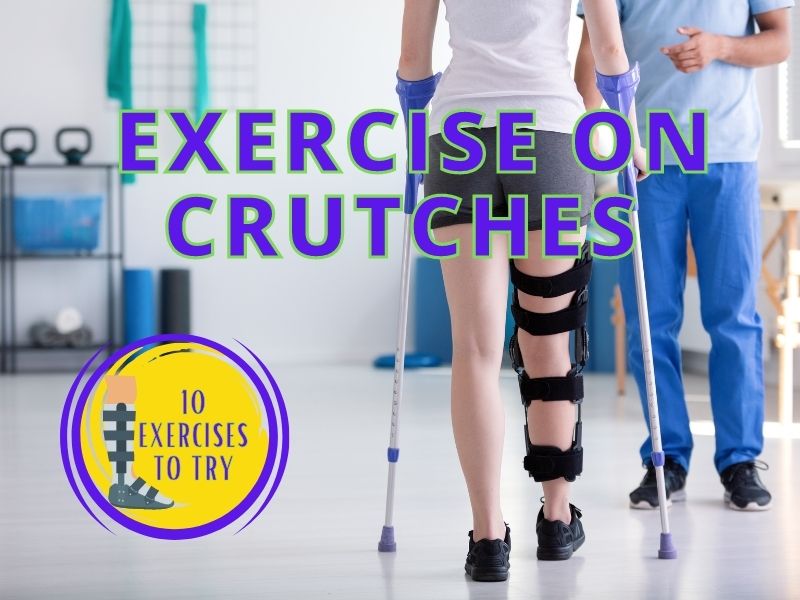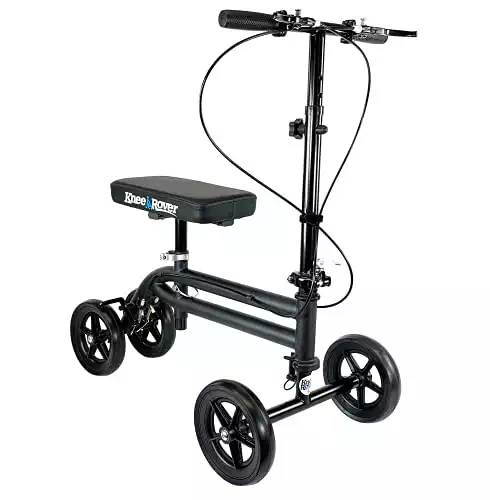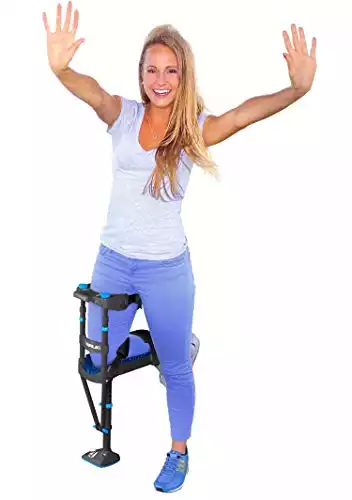If you are someone who has made health and fitness a priority in life, getting injured and ending up on crutches may seem overwhelming. But there is no need to worry anymore because the good news is that you can exercise while on crutches.
There are lots of exercises you can do when using crutches. These exercises put little to no pressure on your legs, so you can exercise and recover from injuries. You can strengthen your muscles and get in some cardio to maintain your physical fitness and health.
Crutches help you to move while healing from an injury. They can be used if you are suffering from lower-body injuries, including legs and hips.
10 Exercises to Try With Leg Injuries
You most likely want to move often if you have a leg injury and have been sedentary for a while. If you wish to be physically fit and stay healthy at this time of your life, follow some of the exercises mentioned below.
- Weight Lifting

If you are on crutches, your shoulders and arms need to be very strong. Even if you aren’t, it’s still beneficial to be physically fit and healthy. Therefore, you may want some hand weights nearby, so you can lift them occasionally.
You can even try to keep some sandbags and lift them with your uninjured leg to make it stronger and ready for anything. With weightlifting, general movement is also necessary for strength building; otherwise, you would loosen up your joints.
- Core Exercises
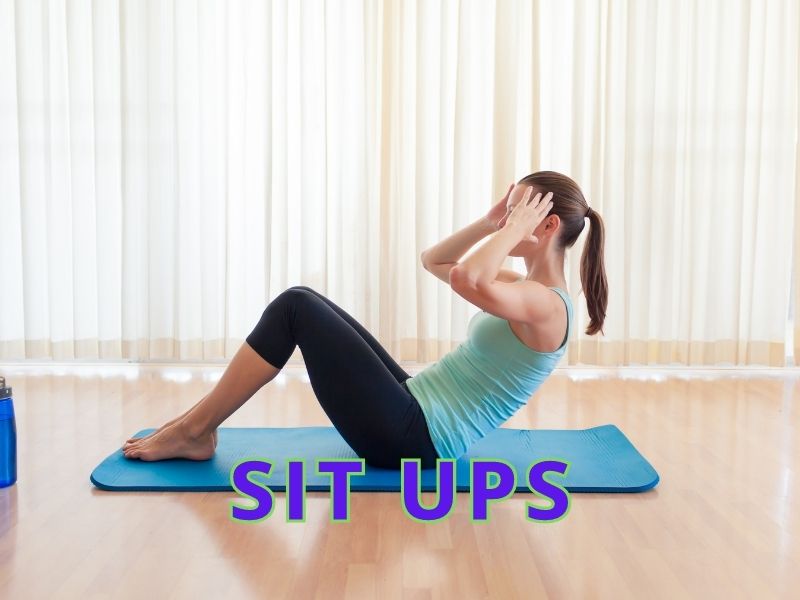
Even if you have injured or broken your leg, there is absolutely no need to ignore your core. You can easily carry out core exercises while sitting or in a lying position. Strengthening your core will reduce your backaches and other physical issues. It will also help you recover from the injury and feel fit and better prepared for recovery.
You can perform core exercises while on crutches in many ways, such as twisting your upper body from one side to the other while keeping the legs and hips still so that your abdominal muscles are working.
You can also do stomach crunches or knee crunches by lifting your knee upright, leaning forward, and back to the upright seated position.
- Swimming

Before practicing this exercise, you need to consult your doctor first; if he is OK with it, you can even swim while on crutches. The reason that aquatic exercises are helpful is they are usually low-impact.
Make sure that you cover your injured leg with a waterproof leg cover if you have a cast. Make sure it is airtight before going into the swimming pool. If you’re careful and don’t submerge it, you can do various exercises in the pool.
The best part about the aquatic workout is that you do not put any pressure on your injured leg; the rest of your body, including your lower portion, is involved in the exercise.
- Walking

While running may not be possible for you right now, walking is still okay unless otherwise advised by your doctor. If you have injured your leg and are using crutches, walking regularly might be harder for you than it looks.
However, it’s still a great workout. Push yourself and try to move around every two hours. If you are using a modern crutch like a knee crutch, walking might be more fun and easier than you might think. Even if you are on traditional crutches, try to get up yourself and go for a walk.
- Yoga

While you won’t be able to perform difficult yoga moves, it’s still one of the best exercises to put your body and mind in tune with each other. Yoga movements and stretches will make you feel balanced and will definitely improve your recovery phase.
It might be difficult for you initially, but not impossible; all you need to do is TRY. It’s also possible that you might find some new things that you would want to add to your regular exercise regimen.
- Straight Leg Raises
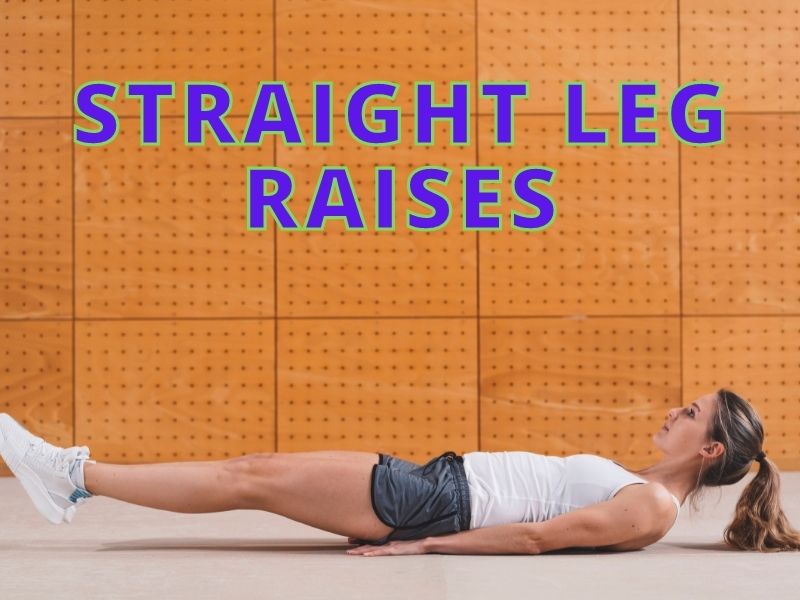
While you are on crutches, you can still strengthen your body and muscles. All you need to do is perform some strengthening exercises. You can go for straight leg raises that will help you to enhance your leg muscles.
Lie on your back and put a pillow under the heel of your bum leg. Bend your good leg while placing your foot flat on the bed. Keep your injured leg straight, lift it a little, and hold it in this lifting position for five seconds. Gradually lower your leg; repeat this five times a day.
- Strengthening Exercises
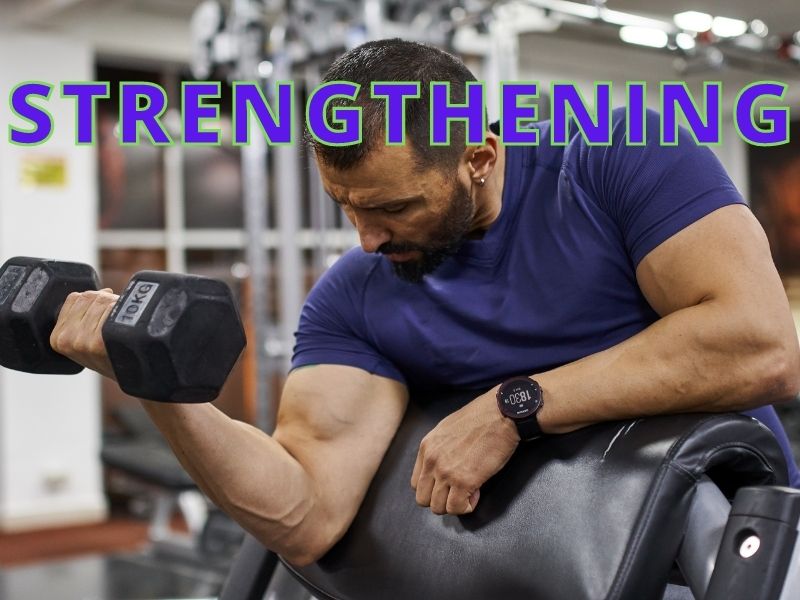
Strengthening exercises with a broken leg focus more on the upper body and abdomen. There are many exercises that you can safely perform at home while on crutches, such as bicep curls, hammer curls, lateral dumbbells, and lat pulldowns.
These exercises work multiple muscles and are good options for you. Also, you need to avoid weight machines that involve a standing position or need leg resistance, as they might not be safe.
- Upper-Body Aerobics

Aerobics-type exercise may be limited to a broken leg. However, you might not be able to carry out many cardio exercises if you use your upper body strategically.
You can use rowing machines because you can handle them with one leg or with your upper body only. You can also punch a heavy bag in a sitting position as it counts in cardio exercise.
If you use a wheelchair, moving the wheels with your hands is another excellent option to exercise effectively and raise your heart rate.
- Arm Exercises

As long as your arms and hands are okay, you can easily do arm exercises. It will improve your cardio strength.
Sit upright on a bench, keep your injured legs in a comfortable position, and carry out the arm strengthening exercises. You have multiple options, including shoulder circles, arm circles, shoulder shrugs, and arm raises.
You can even try punching in different directions to strengthen your shoulders and arms. In the primary stage, you can try lightweight resistance bands and gradually increase the weight later. Still, you need to be very careful not to overdo it.
- Ab Exercises

Besides arms exercises, you can also perform some ab exercises during your recovery phases to improve your abdominal muscles.
You can do sit-ups. In order for you to do them, you need to place your legs in a comfortable position for your injury and tense your abdomen muscles.
It’s not necessary to completely sit up. The important thing is to make sure your leg is supported if needed and find a way to contract your abs for as long as you’re used to.
Here’s how one guy decided to keep fit while he had a cast. He exercised both with his crutches and without them. He wanted to start the day off right with exercise.
Three Ways to Prevent Further Injury When Exercising
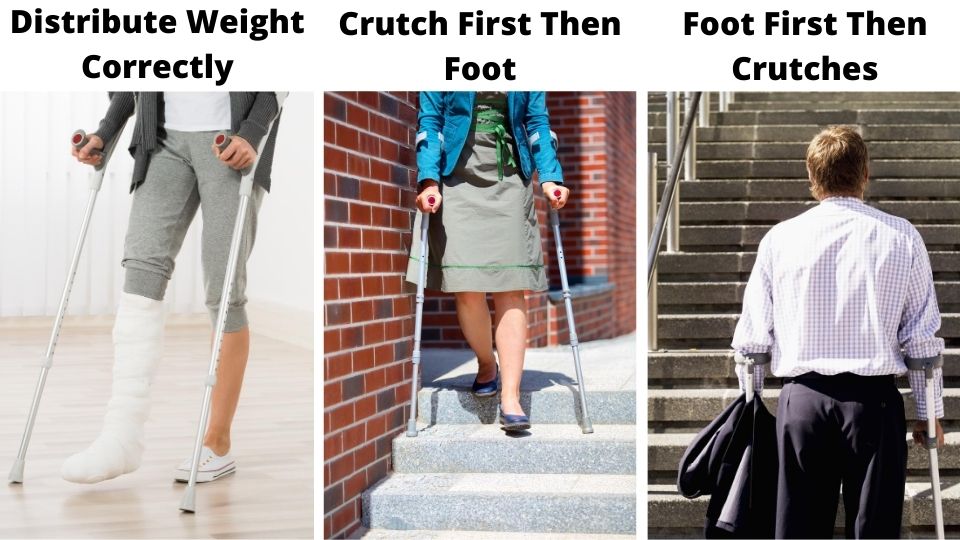
- Walking With Crutches
Keep both crutches in front of you with some distance between the crutches and your good foot. Brace yourself and move your good foot forward.
Take small steps while using crutches. With the support of both hands, let your body swing forward and place the weight on the crutch handles instead of the injured legs.
- Going Downstairs
If a doctor allows it, walk downstairs by placing some weight on the injured leg and supporting yourself with the handrail or one crutch. Firstly, situate the crutches on the next step and then step down on the injured leg, following the good leg quickly.
In case you are unable to bear weight on the harmed leg, hold the foot of the injured leg forward-facing and go down each step with two crutches.
It is crucial to support your body with crutches held a bit in front of you on the next step. You may also utilize the railing on one side and have the support of a crutch on the other hand.
It is recommended to seek assistance from someone, especially if you have weak upper-body strength and lack the strength to hold yourself up.
- Going Upstairs
Stand near the stairs and place the crutches on the floor. As the weight will be on the crutch, move the strong leg up to the first step.
After moving upward, bring the crutch to the step level. Repeat for each progression. Another option, in the case of railings, grasps the crutches beneath one arm, holds the handrail with the other, and continue with the healthy leg.
Devices that Aid with Movement
If you are tired of using crutches, there are other options you might want to try. When I was a teacher, a colleague of mine used a knee scooter to get around school. This made her life easier and a bit more fun. What device would you choose?
Knee Scooter
Hopefully, you will never have to suffer from an ankle or foot injury, but if you do, you should try knee scooters. It permits the user to keep the lower part of the leg relaxed on the knee cushion, making the foot and ankle raised and free from weight.
It also permits the user to move quickly, letting the sufferer move around and travel comfortably. It is close to the ground because of its lower height, making it more stable and less slippery on wet floors. The upper body’s involvement is not required, nor did they lay any stress on hands, wrists, and armpits.
Knee Crutch
If you are someone who has made health and fitness a priority in life, getting injured and ending up on crutches may seem overwhelming. But there is no need to worry anymore because the good news is that you can exercise while on crutches.
A Hands Free Crutch is for those who prefer to walk without restrictions and keep their hands free. A knee crutch will let you keep your weight off from the affected leg, hip, or ankle if you have better upper body strength. They are usable on stairs and rough ground.
- Forearm crutches
Long-term users of crutches prefer forearm crutches as they aid in walking. It also helps in preventing the pain, uneasiness, and harm caused by underarm forearm crutches.
Although the user takes more time to adopt it, it is the best option for comparatively active users.
3 Ways to Get Exercise While Using Your Crutches
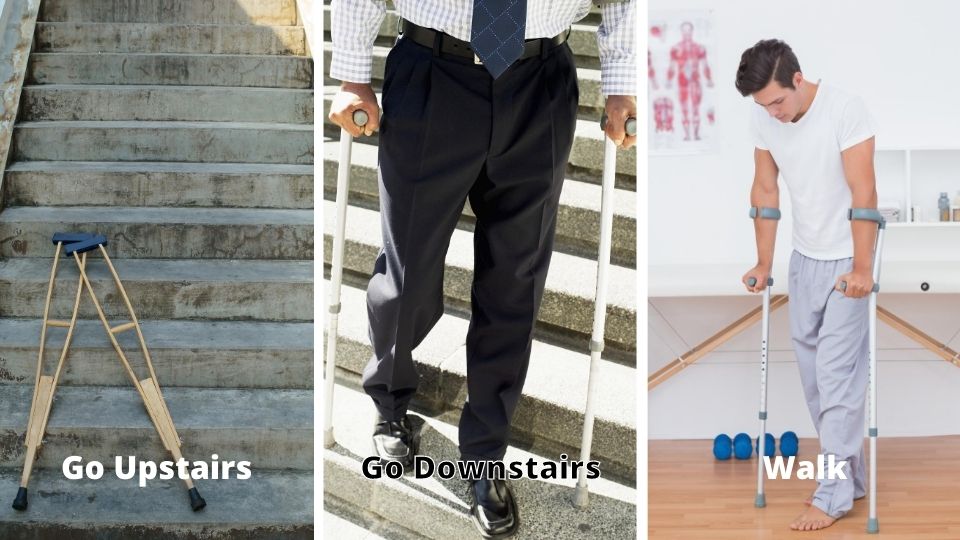
If you are on crutches and still want to do exercises, what’s better than using your crutches while exercising? So now, I am going to give you some ideas on how you can work out using your crutches.
- Stair Climbing
Going up the stairs or climbing stairs, whatever you call it, can be a great exercise for you to do using crutches. It doesn’t matter if you have a railing or not; if it’s not available, climb the stairs using your good leg.
Put your strong leg on the step and then the crutches. Your weight needs to be on the crutch’s handgrips.
Once you raise your body to the next stair, let your injured leg follow. Do not put any pressure on your injured leg. Continue the process. Make sure that your toes clear the steps before moving to the next step.
- Going Down The Stairs
Going downstairs is another exercise you can do using your crutches. It’s similar to climbing up; all you need to do is reverse the process.
While moving downstairs, you need to make sure that your toes are closer to the edges of the steps before moving to the next step. Put the crutches on the step below, lower your weak leg onto the stair, and put all your weight on the crutches’ hand grips. Now, step down with your good leg. Continue the process until you reach ground level.
- Walking
Walking is another easy exercise that you can do using your crutches. Place the crutches in front of you, about 8 to 12 inches away.
Put your weight on the weak leg only if the doctor says it’s OK; otherwise, swing it through. Step through with the strong leg while pushing down the handgrips. Move your crutches forward and continue with the process.
Final Thoughts
If you are interested in exercising with your crutches during your recovery period, it’s good to know that there are many options available for you to get the exercise you need.
Good luck with your exercise goals and with your recovery if you are using crutches now.
Thanks for visiting Helpshoe.com
References
https://cdn2.hubspot.net/hubfs/123998/eBook_Offers/Exercise_Guide/exercise-guide1.pdf
https://www.sportsrec.com/7560809/the-best-way-to-exercise-with-a-broken-leg
https://www.sportsrec.com/106522-exercises-people-crutches.html
https://luxurydx.com/crutches-exercise/
https://independentlyyours.org/product-articles/do-i-need-a-knee-scooter-or-crutches/

